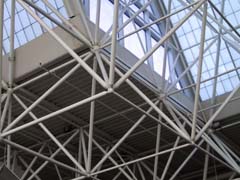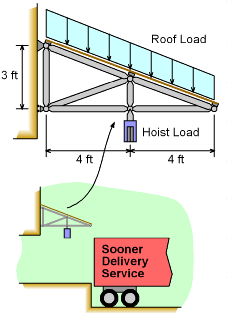| Ch 9. Columns | Multimedia Engineering Mechanics | ||||||
|
Basic Columns |
Fixed Columns |
Eccentric Loads |
|||||
| Basic Columns | Case Intro | Theory | Case Solution | Example |
| Chapter |
| 1. Stress/Strain |
| 2. Torsion |
| 3. Beam Shr/Moment |
| 4. Beam Stresses |
| 5. Beam Deflections |
| 6. Beam-Advanced |
| 7. Stress Analysis |
| 8. Strain Analysis |
| 9. Columns |
| Appendix |
| Basic Math |
| Units |
| Basic Equations |
| Sections |
| Material Properties |
| Structural Shapes |
| Beam Equations |
| Search |
| eBooks |
| Dynamics |
| Fluids |
| Math |
| Mechanics |
| Statics |
| Thermodynamics |
| Author(s): |
| Kurt Gramoll |
| ©Kurt Gramoll |
|
|
||
| Introduction |
||
|
|
The manager at the loading dock thought it would be a good idea to install an electric hoist under the existing canopy. If installed on a rail system, then large loads can be easily lifted and moved to another truck. The existing canopy is constructed from 1.5" O.D. pipes that are connected
with ball joints. There is one truss for every 5 feet of canopy. The canopy roof
needs to carry at least 60 lb/ft2 for possible dead and live loads
(wind, weight, snow, etc.).
|
|
| Question |
||
|
What is the maximum weight that the hoist can lift (ignore weight of the hoist
itself) for the existing canopy with a factor of safety of 2.0? |
||
 3D Truss Example at the Milwaukee Airport |
||
| Approach |
||
|
||
Practice Homework and Test problems now available in the 'Eng Mechanics' mobile app
Includes over 500 free problems with complete detailed solutions.
Available at the Google Play Store and Apple App Store.
